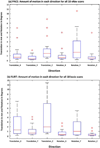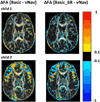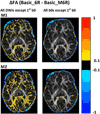Motion artifact reduction in pediatric diffusion tensor imaging using fast prospective correction
- PMID: 24935904
- PMCID: PMC4269573
- DOI: 10.1002/jmri.24678
Motion artifact reduction in pediatric diffusion tensor imaging using fast prospective correction
Abstract
Purpose: To evaluate the patterns of head motion in scans of young children and to examine the influence of corrective techniques, both qualitatively and quantitatively. We investigate changes that both retrospective (with and without diffusion table reorientation) and prospective (implemented with a short navigator sequence) motion correction induce in the resulting diffusion tensor measures.
Materials and methods: Eighteen pediatric subjects (aged 5-6 years) were scanned using 1) a twice-refocused, 2D diffusion pulse sequence, 2) a prospectively motion-corrected, navigated diffusion sequence with reacquisition of a maximum of five corrupted diffusion volumes, and 3) a T1 -weighted structural image. Mean fractional anisotropy (FA) values in white and gray matter regions, as well as tractography in the brainstem and projection fibers, were evaluated to assess differences arising from retrospective (via FLIRT in FSL) and prospective motion correction. In addition to human scans, a stationary phantom was also used for further evaluation.
Results: In several white and gray matter regions retrospective correction led to significantly (P < 0.05) reduced FA means and altered distributions compared to the navigated sequence. Spurious tractographic changes in the retrospectively corrected data were also observed in subject data, as well as in phantom and simulated data.
Conclusion: Due to the heterogeneity of brain structures and the comparatively low resolution (∼2 mm) of diffusion data using 2D single shot sequencing, retrospective motion correction is susceptible to distortion from partial voluming. These changes often negatively bias diffusion tensor imaging parameters. Prospective motion correction was shown to produce smaller changes.
Keywords: diffusion tensor imaging (DTI); navigated diffusion sequence (vNav); prospective motion correction; retrospective motion correction; tractography.
© 2014 Wiley Periodicals, Inc.
Figures







References
-
- Miller JH, McKinstry RC, Philip JV, Mukherjee P, Neil JJ. Diffusion-tensor MR imaging of normal brain maturation: a guide to structural development and myelination. AJR Am J Roentgenol. 2003;180:851–859. - PubMed
-
- Mukherjee P, Miller JH, Shimony JS, et al. Normal brain maturation during childhood: developmental trends characterized with diffusion-tensor MR imaging. Radiology. 2001;221:349–358. - PubMed
-
- Qiu D, Tan LH, Zhou K, Khong PL. Diffusion tensor imaging of normal white matter maturation from late childhood to young adulthood: voxel-wise evaluation of mean diffusivity, fractional anisotropy, radial and axial diffusivities, and correlation with reading development. Neuroimage. 2008;41:223–232. - PubMed
Publication types
MeSH terms
Grants and funding
- R21AA017410/AA/NIAAA NIH HHS/United States
- R21MH096559/MH/NIMH NIH HHS/United States
- R21EB008547/EB/NIBIB NIH HHS/United States
- P41RR014075/RR/NCRR NIH HHS/United States
- U19 AI053217/AI/NIAID NIH HHS/United States
- R21 AA017410/AA/NIAAA NIH HHS/United States
- R21 MH096559/MH/NIMH NIH HHS/United States
- R01 HD071664/HD/NICHD NIH HHS/United States
- R21 EB008547/EB/NIBIB NIH HHS/United States
- P41 RR014075/RR/NCRR NIH HHS/United States
- R01HD071664/HD/NICHD NIH HHS/United States
- U19 AI53217/AI/NIAID NIH HHS/United States
LinkOut - more resources
Full Text Sources
Other Literature Sources

